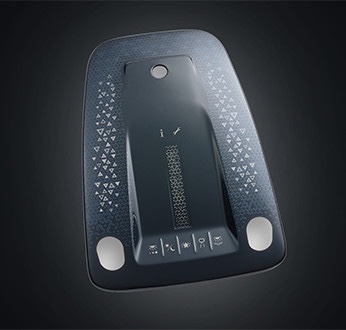Finishing & Screen Printing
KURZ shows highly efficient one-step process for the vehicle of tomorrow with strong partners

Thursday 07. October 2021 - One of the numerous highlights of the trade fair presentation, which will be held under the motto Making every product unique, will be the groundbreaking, partly award-winning concept components for the vehicle of tomorrow.
Together with renowned partner companies, LEONHARD KURZ will be presenting innovative and sustainable surface solutions for plastics at Fakuma in October 2021.
“In order to demonstrate the multi-faceted future of interior design to trade fair visitors, as a ‘partner for future supplier challenges’ we will be showing a directly functional HMI concept component for the roof lining, among other things, together with injection moulding machine manufacturer Wittmann Battenfeld and plastics specialist and mould technologist Syntech Plastics at the trade fair,” announces Martin Hahn, Head of Application, Technology & Innovation Business Area Plastic Decoration at LEONHARD KURZ. Important building blocks for the successful concept shown at Fakuma were also supplied by lighting specialist OSRAM Automotive Lighting Systems, and KURZ subsidiaries Baier with the CO2 purification and UV curing system, as well as POLY IC with the 3D-moulded PolyTC touch sensors. The highly efficient, series-production-capable one-step process can be seen via live transmission in Hall B1 at Stand B1-1204 of Wittmann Battenfeld Deutschland GmbH.
Extensive functions with unlimited design freedom
The seamlessly closed Overhead Light Console (OHLC) features in-mould electronics for controlling a wide range of functions. The integrated touch control in Shy-Tech and Day-Night design allows, for example, operation of the sunroof or the reading lights. The highly transparent and thus invisible PolyTC sensors are used in the visible area of the LED light surfaces. The organic three-dimensional deformation of the component surface emphasises the intuitive operation of the touch sliders and buttons.
From backlighting and depth effects to different colour variants and decors to customer-specific specifications for durability, all conceivable variants can be realised. There are no limits to design freedom: The black high-gloss look is just as possible as super-matt or even soft-touch surfaces. Depending on the customer’s wishes, graphic or natural decors, for example in wood look, can also be used. Integrated gobo projectors can also be used to project logo or branding elements onto the centre console.
New principle optimises sensor integration
The series-production-capable and particularly efficient in-mould decoration (IMD) process, which is realised by means of a single image in the classic roll-to-roll process, combines injection moulding, sensor integration by means of functional in-mould labelling and decoration in one highly efficient work step. During component production, visitors to the trade fair can see the KURZ and POLY IC patented innovation for themselves in a live stream at the Wittmann Battenfeld stand: for example, the integration of the 3D-moulded sensors is carried out according to the new “tail from the middle” principle. A sliding device brings the sensor tail to a 45-degree angle to the component, which ensures perfect edge decoration beyond the mould edge. In addition, the sensor tail has a non-stick coating that enables easy connection on the back.
Cost-effectiveness goes hand in hand with sustainability
Compared to competitive processes – such as painting or physical vapour deposition (PVD) – in-mould decoration is not only significantly more economical, but also more sustainable. By combining various work steps into a one-shot process, CO2 emissions can be noticeably reduced. Because the decoration layers are transferred to the component as a dry paint system, wet paint contamination and post-drying energy are a thing of the past. Neither the wafer-thin touch sensors, which replace all the previously necessary switches and buttons, nor the decorative layers affect the recyclability of the component. Further improvements in the eco-balance and a saving of resources can also be achieved if recycled materials are used in the injection moulding process. Depending on the customer’s requirements, these can either be visually accentuated by an appropriate finish or concealed under a wafer-thin layer of lacquer.
